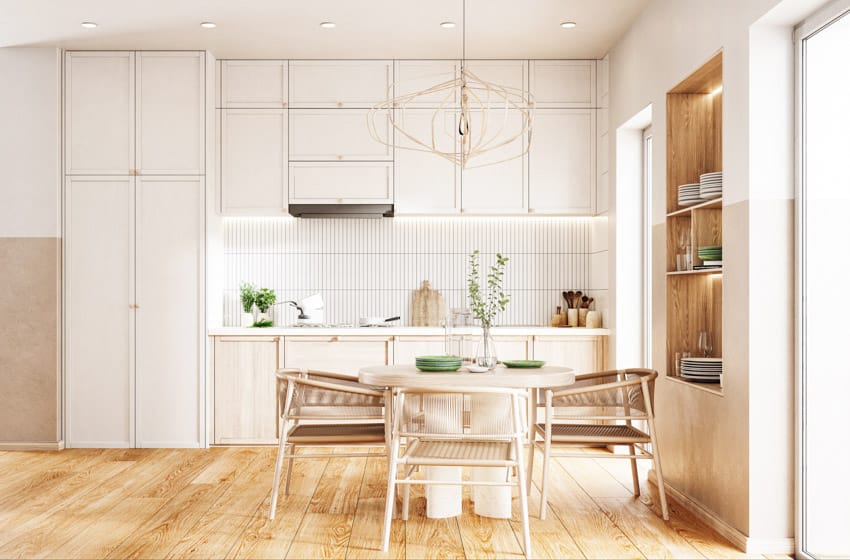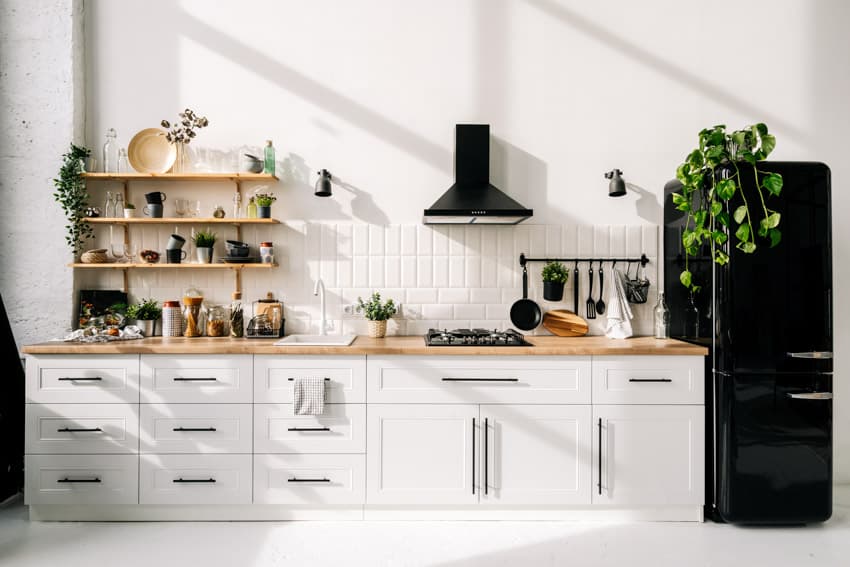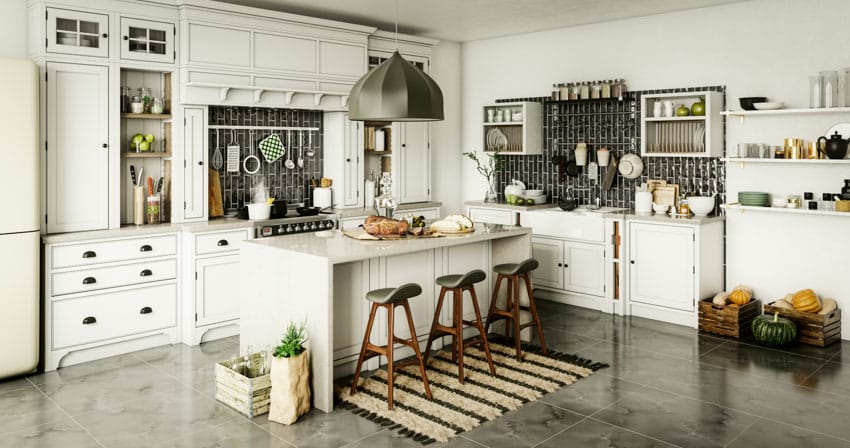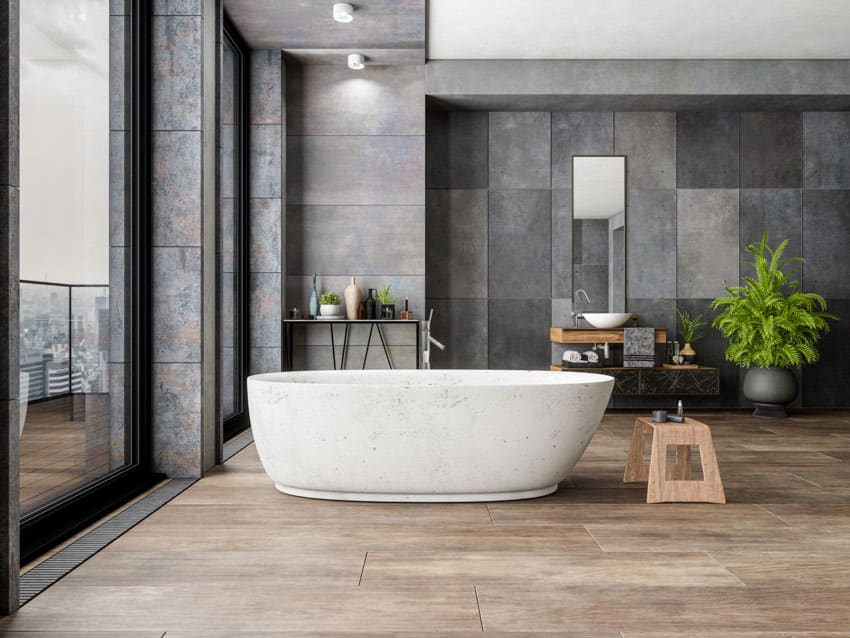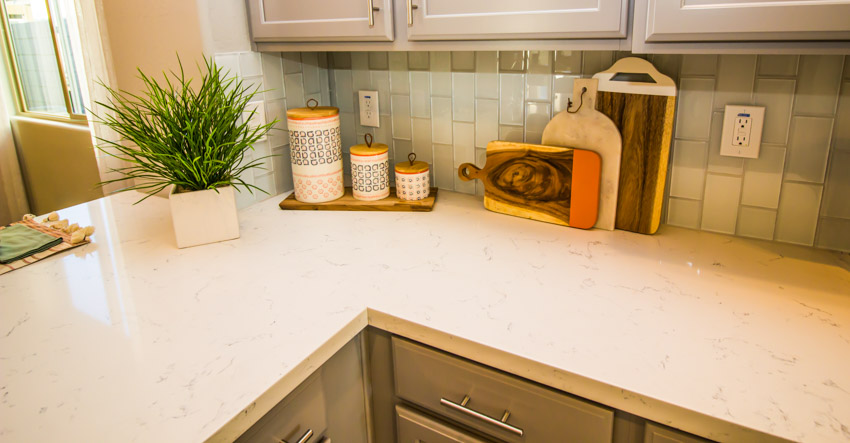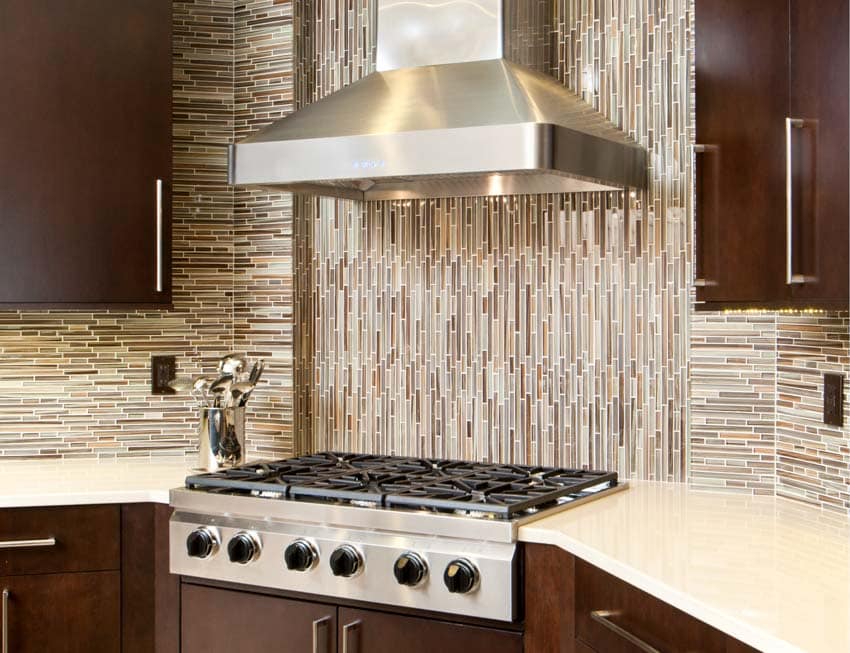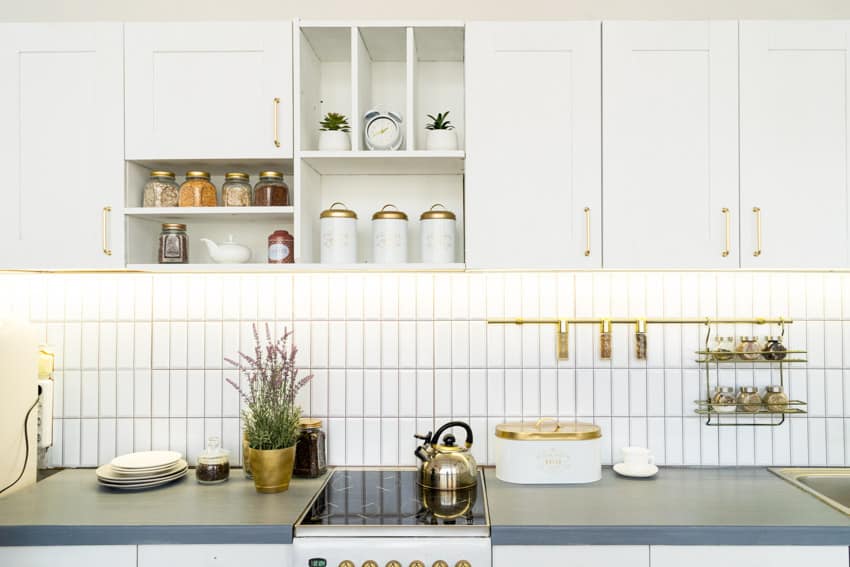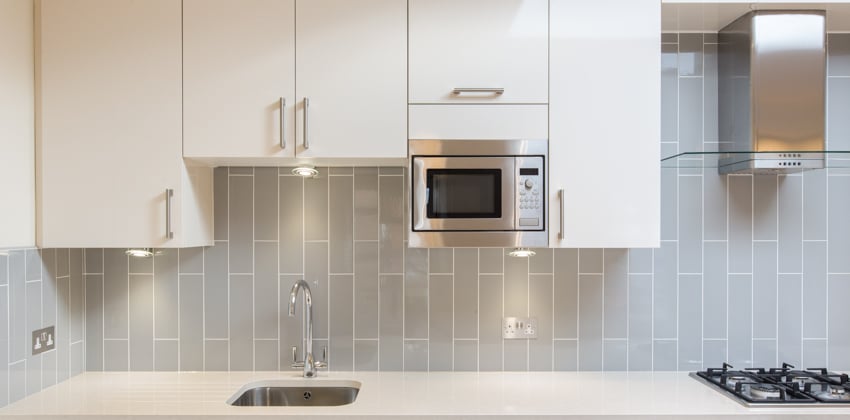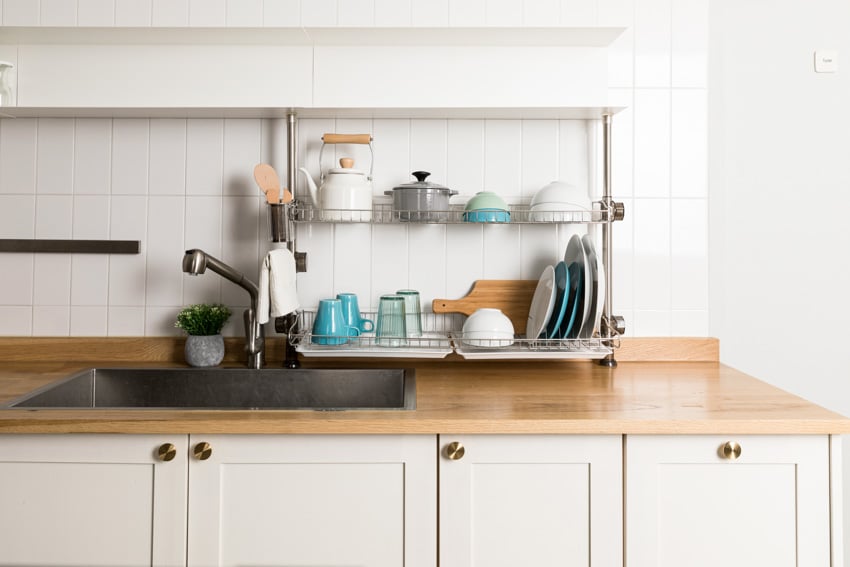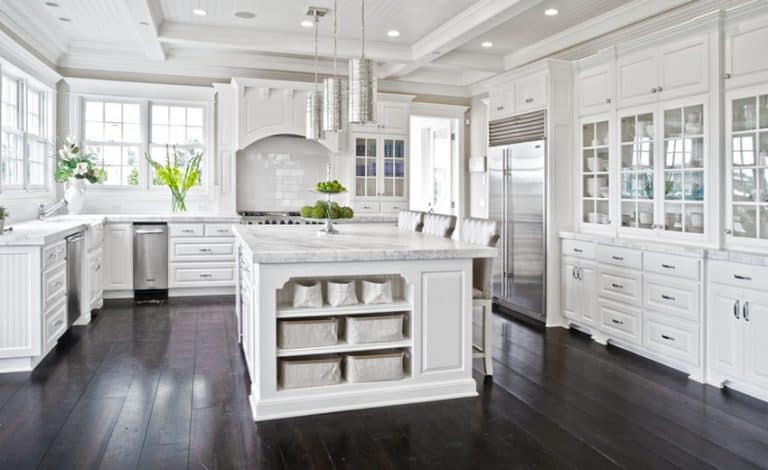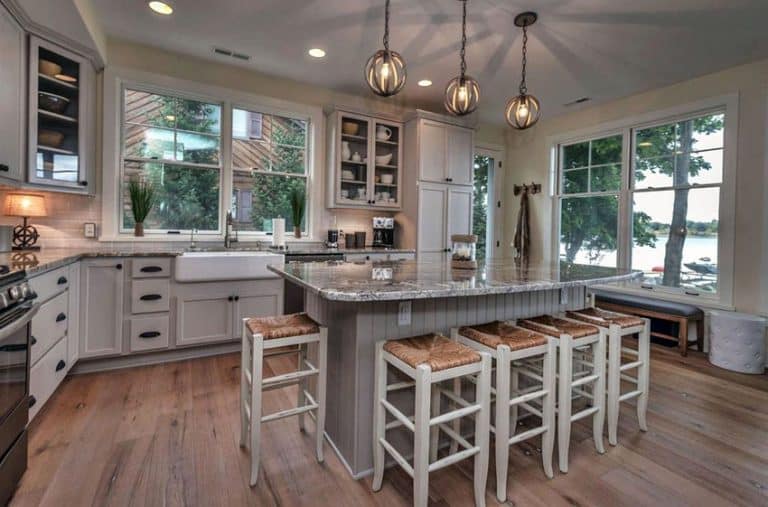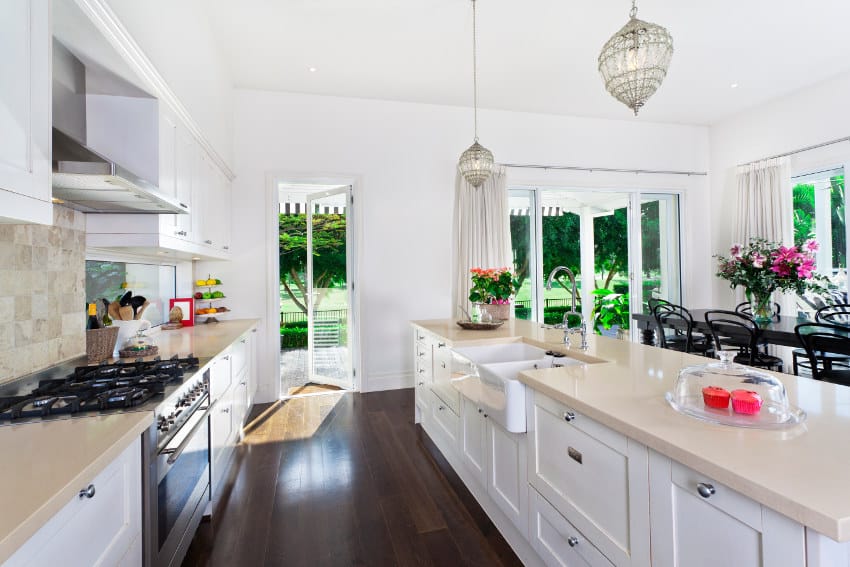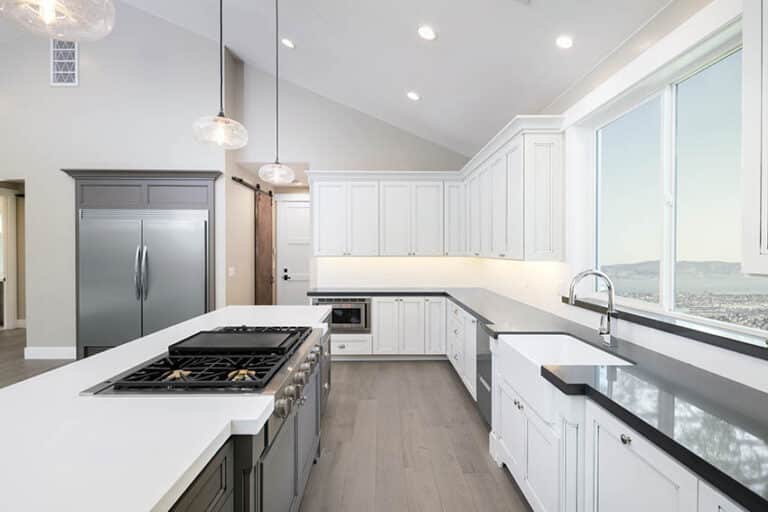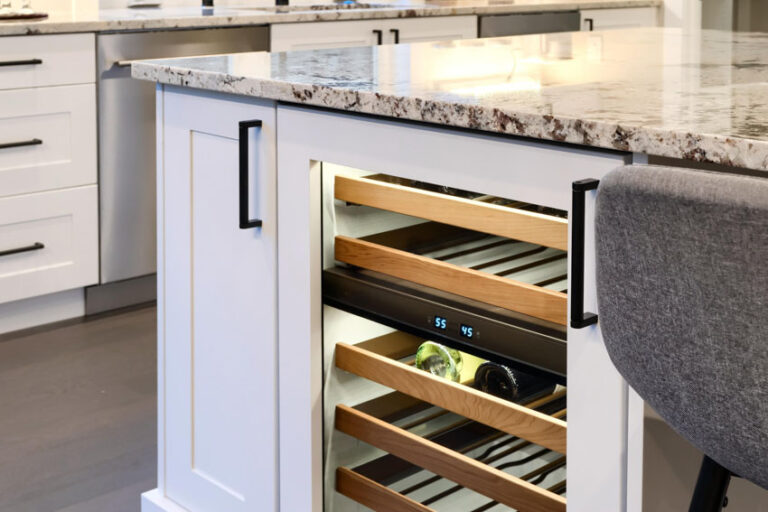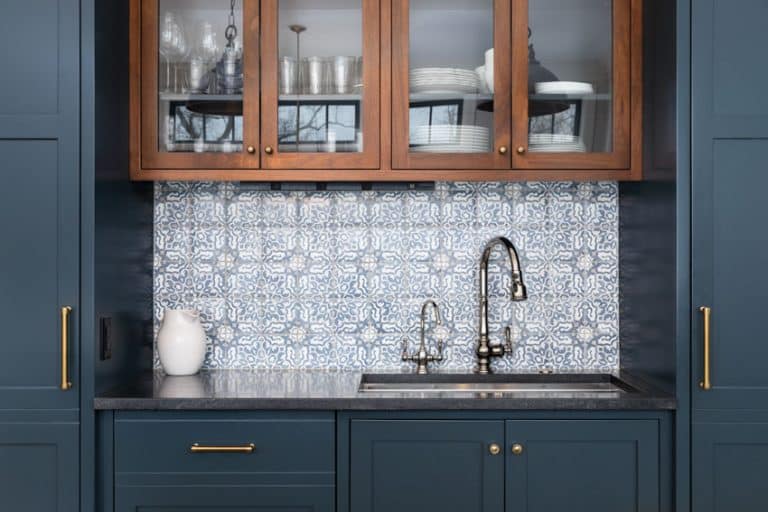Vertical Tile Backsplash (Types & Layout Tips)
Interior design is ever-evolving and one of the latest trends to break design norms is vertical tiling which showcases a bold and unique design statement. A vertical tile backsplash is where tiles are oriented vertically along their longest side instead of the typical horizontal position.
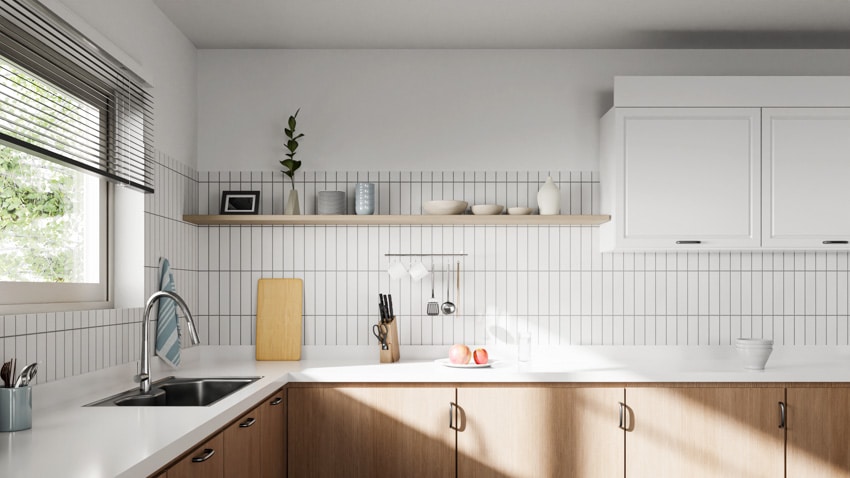
This new aesthetic spin is a refreshing approach and, at the same time, can be practical as it can visually expand tightly spaced kitchens. Vertical tiles are also used on external applications such as walls and roofing.
Where to Use Vertical Tile Backsplash
Kitchen: A kitchen backsplash acts as an extra layer that will keep moisture, water, oils, and other debris when prepping or cooking food from getting into your structural walls made from drywall or concrete. It’s an inexpensive kitchen update where tiles are simply flipped on their vertical side saving more materials.
Rangehood and Cooking Range: Sectional tiling usually leads to higher material wastage, especially with intricate designs such as hexagonal shapes.
The wall section where your range hood and cooking range will typically have a long vertical area starting at the backside of your oven range that continues above your range hood with your ceiling mold as the threshold.
Installing a vertical tile backsplash tricks the eye of having more space. With a different tiling material, the backdrop is a perfect accent wall adding depth and movement to a rather constrained space.
Kitchen Counters: The kitchen countertop runs along a horizontal orientation with the typical cupboards in a parallel position. A vertical tile backsplash breaks the horizontality of your elements, creating a dimensional and contrasting effect and making your space more exciting and visually pleasing.
Open Shelving: Bring the vertical tile backsplash installed above your counter way up to your kitchen ceiling to create visual continuity. The backdrop of vertical tiles with open shelving features a clean and simple aesthetic. Sectional tiling can also be done to draw attention to open types of shelves.
Bathroom: The earliest adopters of vertical tile backsplash are the bathroom area. The modern touch suits ensuite bathrooms with limited spaces since the vertical tiles draw the eyes upwards, creating an illusion of space.
Shower Area: The shower areas are usually narrow, and vertical tile cladding will make the space visually less confining besides having an attractive accent wall.
A vertical tile shower backsplash is an excellent way to introduce different colors and textures to a modern bathroom. Rich and colorful vertical tiles as a backdrop create a warmer vibe rather than sticking to the minimalistic design.
Vanity Counters. Mantel or round mirrors are popular right now that suits contemporary bathrooms. These types of mirrors can leave a few areas on your wall, and sometimes tiles can have less visual impact.
A vertical tile backsplash can have a more visually striking effect as the change in direction draws the eyes to the element. Glass and other unique materials can be used to have a more translucent effect that blends perfectly with mirrors, creating an illusion of space. Sometimes a strip or one layer of vertical tiles is enough to make an exciting addition to your vanity space.
Accent Band: Traditional accent bands have tirelessly used mosaic tiles in creating decorative features, and vertical tiles are a great alternative to break a monotonous wall. Lining up a single row of tall vertical backsplash tile on top of your kitchen counter or vanity is another great way to add a new dimension to the space.
Powder Rooms: A vertical tile backsplash can work in a powder room, but with caution, especially when you have a high ceiling clearance, as it can create the “elevator shaft” effect. Use your vertical tile backsplash sparingly if you have a high ceiling with a tight space—an accent band along with horizontal tiles.
Fireplace: The mantel or chimney piece is the perfect architectural element to feature in a home. Most mantelpieces have a low profile, and a vertical backsplash tile can add grandeur and emphasis to a fireplace tile design.
As virtually every type of tile is available as vertical tiles, there’s a material and color suitable for either a modern or traditional-themed fireplace.
Popular Types Of Vertical Backsplash Tiles
Here we share the different types of upright backsplash tiles.
Vertical Subway Tile
Subway tiles continue to be popular as they give that modern, contemporary look with their straightforward design. As a rule of thumb, any tile with a 1 to 2 size can be categorized as a subway tile and with the standard size of 3 x 6 inches.
There are other sizes available today, but manufacturers of subway tiles commonly have 2 x 4, 4 x 8, and 6 x 12 sizing. Orienting the subway tile backsplash on its upright side provides an updated look with the popular straight-set pattern.
Picket Tile with Vertical Design
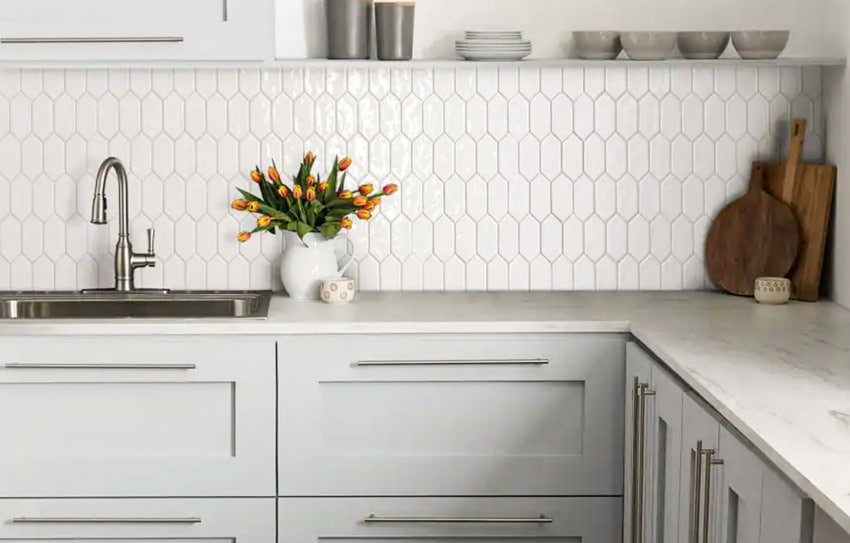
Since the introduction of hexagon tiles in the 1900s, this geometric tile has been a popular alternative to straight-edged rectangular tiles inspiring the new trend of picket tiles.
Despite being associated with the art-deco and modern aesthetics, the hexagon is a recurring shape in nature, found in beehives, turtle shells, snowflakes, and dragonfly eyes.
For this reason, hexagon tile shapes such as picket tiles are visually pleasing, and there’s a sense of familiarity with the organic shape. Picket tile backsplash with a vertical design can showcase a modern and updated look with its sleek, elongated shape while having that visual ease innate in humans.
Large format Tiles
Large format tiles were once exclusive for commercial use and eventually made into consumers’ homes. A sizeable upright tile backsplash provides a dramatic and modern aesthetic. Years ago, a 12-inch tile was considered a large format.
However, changes in the tiling industry today generally think of a tile with 15-inch or more as a large format tile. Having fewer grout lines creates the clean minimal look of modern interiors, and with a upright orientation, a large upright tile backsplash easily creates that modern look.
Besides having a sleeker surface, large upright tiles are easier to clean and maintain with less visible grout lines. A large format tile creates a more luxurious and expansive look for spacious areas such as the living and dining area. The upright cladding can also make a feature wall stand out significantly when extended upwards toward the ceiling.
Upright Glass Tiles
Orienting narrow glass tiles in the upright position can create the visually appealing waterfall effect, with dual tones or having one color in varying tones. The upright glass tiles are perfect for shower areas, either offset or stacked uniformly.
Glass backsplash tiles are reflective and translucent, which can make a luxurious feature wall. Line the upright tiling with brass or gold grouting, and you’ll get an opulent and attractive wall cladding.
Upright Mosaic Tiles
Mosaic tiles are smaller pieces of tiles with various colors and textures usually laid out to form or create a pattern or image. Mosaic tiles have been around since ancient times and are a popular tile design for both traditional and contemporary interiors.
A trend in wall tiling is where upright mosaic tiles backsplash in monochromatic colors are laid out to create a pixel-like representation of the aesthetic of the digital age. A more conventional option is to have the upright mosaic tiles stacked vertically side by side in glass or ceramic material.
Other Designs: Three-Dimensional Upright Tiling Backsplash. New trends in upright tiling include wavy tiles with designs extruding from the surface, creating geometric shapes or patterns.
The 3D upright tile backsplash can be alternated with your regular flat surface upright tiling to create a pattern that gives a textured surface. This upright tiling is an interesting wall cladding to explore, especially when layering light and shadow on featured walls. The texture and shape provide interesting personality and add visual interest.
Backsplash Layout
Tiles, in general, are a versatile cladding material with a rectangular shape, offering many installation options. This versatility makes it easy to mix and match with other shapes and orientations.
UprightOffset: An upright offset is also known as the traditional brick tile pattern or running bond, where upright tiling is laid with their adjoining edges positioned at the center (half of the tile) of the next block in line.
This creates an alternating pattern considered to have stronger structural integrity for load-bearing bricks. For backsplashes, the upright offset creates an interesting visual movement and, when installed from the finished floor level to the ceiling, makes an eye-catching wall feature.
Upright Straight Set: The upright tiling is laid with each tile stacked parallel to each other, creating a uniform alignment of the grouts. The upright straight set creates a clinical vibe to a space that has a clean and modern aesthetic. Contrasting the uniform look with warmer and richer colored tiles makes it a visually attractive wall feature.
Upright Offset (Alternate): Like the upright offset, the adjoining edges of the tiles are aligned at the middle part of the tile, but this time the offset is done along the vertical axis. Since there is a limited area to cover with a upright offset, it is best to use the layout on wider spans of wall area.
Should Backsplash Tile Be Horizontal Or Vertical?
Choosing between a horizontal or upright tiling orientation can be a dilemma, especially when both are aesthetically pleasing on a feature wall. To help you decide which to choose, it is best to consider other elements surrounding your feature wall and the visual effect of upright tiling when matched with these elements.
Scale: Upright tiling that looks too long can look odd when installed in a very short space. Consideration should be made to the clearance between the floor-finished flooring and ceiling line.
When a professional is hired, the interior designer is likely to present you with 3D simulations and drawings to help you visualize how the upright looks once installed in your space.
Perspective. Factors such as the shape and size of tiles can significantly affect your visual perspective of a room. Upright tiling tends to elongate a space tricking the eye into perceiving a higher ceiling. This should be in consideration when opting for upright tiles.
Upright tiling can also make a room look claustrophobic, so make sure to balance elements and remember contrast when matching them.
Unlike chevron or herringbone backsplash tile, which can work in both upright and horizontal directions, an upright tiling backsplash is usually an effective way to make a room look higher.
Color. Along with scale and perspective, color is an important factor to consider. Darker colors are a striking feature against light elements but can be overbearing when used extensively.
Light colors offer a clean and airy feel. Light on light colors is great in kitchen and bathroom areas where increasing light is most desirable.
Dark, cool colors such as green or blue can add a dramatic feature, especially with a glass or metallic element. Darker colors such as brown or black meanwhile add mood to a space.
Horizontal: Tiles oriented in the horizontal position generally make a space look more expansive. Limited floor space will benefit from horizontal tiling, visually opening up space as the lines run sideways.
Medium-sized tiles are recommended as large format tiles may not be noticeable, especially with narrow grouts. Small tiles may not be practical for wet areas as mold and mildew can quickly accumulate over time between grouts.
Vertical: With a low ceiling, an upward tiling layout effectively draws the eyes upward and creates the illusion of upward space. A wider floor area can use sectional tiling, creating feature walls and emphasizing architectural details.
Be mindful, though, of how it looks with a very high ceiling. Lofts and atriums can use upward tiling layouts to emphasize grandeur but usually balance the verticality with an added width.
What Style Does Vertically Oriented Backsplash Belong To?
Bold and modern, the upward tiling backsplash is considered under the contemporary aesthetic. Upright tiling was popular during the 19th to 20th century and was extensively used during the Arts and Crafts movement.
Upright tiling became popular during the Arts and Crafts movement in the late 19th Century and early 20th Century, and it is often used today to add detail to buildings, particularly at the first-floor level and at gable ends as well as around dormer windows.
See more related content in our article about the best quartz kitchen backsplash ideas on this page.

